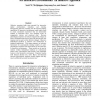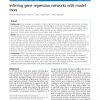186 search results - page 16 / 38 » Globally Induced Model Trees: An Evolutionary Approach |
AIIDE
2006
13 years 10 months ago
2006
Affective reasoning holds great potential for interactive digital entertainment, education, and training. Incorporating affective reasoning into the decision-making capabilities o...
BMCBI
2010
13 years 8 months ago
2010
Background: Novel strategies are required in order to handle the huge amount of data produced by microarray technologies. To infer gene regulatory networks, the first step is to f...
JEA
2008
13 years 8 months ago
2008
As more and more genomes are sequenced, evolutionary biologists are becoming increasingly interested in evolution at the level of whole genomes, in scenarios in which the genome e...
ICADL
2007
Springer
14 years 2 months ago
2007
Springer
With the rapid emergence and proliferation of Internet and the trend of globalization, a tremendous amount of textual documents written in different languages are electronically ac...
ATVA
2007
Springer
14 years 2 months ago
2007
Springer
Abstract. Dynamic fault trees (DFTs) are a versatile and common formalism to model and analyze the reliability of computer-based systems. This paper presents a formal semantics of ...


